Quantitative Analysis of Cenozoic Extension in the Qiongdongnan Basin, South China Sea: Insight on Tectonic Control for Hydrocarbon Reservoir Accumulation and Formation
Abstract
:1. Introduction
2. Geological Background
3. Data and Methods
3.1. Dataset
3.2. Methods
3.2.1. Calculation of the Amount of Extension
3.2.2. Fractal Computing
4. Results
4.1. Cenozoic Nonuniform Extension in the Qiongdongnan Basin
4.2. Multistage Extension of Qiongdongnan Basin
4.3. Migration of Subsidence Center in Qiongdongnan Basin
5. Discussion
5.1. Mechanism of Uneven Distribution of the Extensional Capacity within the Qiongdongnan Basin
5.2. Tectonic Control on Hydrocarbon Source, Reservoir Accumulation, and Formation in Qiongdongnan Basin
6. Conclusions
Author Contributions
Funding
Institutional Review Board Statement
Informed Consent Statement
Data Availability Statement
Conflicts of Interest
References
- Jiao, S.T.; Zhou, Y.Z.; Zhang, Q.; Jin, W.J.; Liu, Y.P.; Wang, J. Study on intelligent discrimination of tectonic settings based on global gabbro data from GEOROC. Acta Petrol. Sin. 2018, 34, 3189–3194. (In Chinese) [Google Scholar]
- Zuo, R.G.; Xia, Q.L.; Wang, H.C. Compositional data analysis in the study of integrated geochemical anomalies associated with mineralization. Appl. Geochem. 2013, 28, 202–211. [Google Scholar] [CrossRef]
- Zhou, Y.Z.; Chen, S.; Zhang, Q.; Xiao, F.; Wang, S.G.; Liu, Y.P.; Jiao, S.T. Advances and prospects of big data and mathematical geoscience. Acta Petrol. Sin. 2018, 34, 255–263. (In Chinese) [Google Scholar]
- Zhou, Y.Z.; Wang, J.; Zuo, R.G.; Xiao, F.; Shen, W.J.; Wang, S.G. Machine learning, deep learning and Python language in field of geology. Acta Petrol. Sin. 2018, 34, 3173–3178. (In Chinese) [Google Scholar]
- Luo, Z.J.; Xiong, Y.H.; Zuo, R.G. Recognition of geochemical anomalies using a deep variational autoencoder network. Appl. Geochem. 2020, 122, 104710. [Google Scholar] [CrossRef]
- Xiong, Y.H.; Zuo, R.G. Recognizing multivariate geochemical anomalies for mineral exploration by combining deep learning and one-class support vector machine. Comput. Geosci. 2020, 140, 1044484. [Google Scholar] [CrossRef]
- He, C.; Long, G.Y.; Wu, S.M. Esimation of the stretching factors of the Qiongdongnan Basin and domino-style fault model. Geotecton. Et Metallog. 2012, 36, 204–208. (In Chinese) [Google Scholar]
- Shi, X.; Jiang, H.; Yang, J.; Yang, X.; Xu, H. Models of the rapid post-rift subsidence in the eastern Qiongdongnan Basin. South China Sea: Implications for the development of the deep thermal anomaly. Basin Res. 2017, 29, 340–362. [Google Scholar] [CrossRef]
- Sun, Z.; Wang, Z.; Sun, Z.P.; Wang, Z.W.; Zhang, W.; He, L.J. Structure and kinematic analysis of the deepwater area of the Qiongdongnan Basin through a seismic interpretation and analogue modeling experiments. Acta Oceanol. Sin. 2015, 34, 32–40. [Google Scholar] [CrossRef]
- Zhu, W.L.; Zhong, K.; Li, Y.C. Characteristics of hydrocarbon accumulation and exploration potential of the northern South China Sea deepwater basins. Chin. Sci. Bull 2012, 57, 3121–3129. [Google Scholar] [CrossRef] [Green Version]
- Zhu, W.L.; Xie, X.N.; Wang, Z.F.; Zhang, D.J.; Zhang, C.L.; Cao, L.C.; Shao, L. New insights on the origin of the basement of the Xisha Uplift, South China Sea. China Earth Sci. 2017, 60, 2214–2222. [Google Scholar] [CrossRef]
- Zhang, Y.; Pei, J.X.; Zhou, Y.Z.; Zhu, J.T.; Chen, Y. The application of nonlinear technique in provenance analysis and reservoir parameter prediction at the Lingshui17-2 gas field of Qiongdongnan Basin. Acta Geol. Sin. 2016, 90, 559–568. (In Chinese) [Google Scholar]
- Xie, X.N.; Müller, R.D.; Li, S.T.; Gong, Z.; Steinberger, B. Origin of anomalous subsidence along the northern South China Sea margin and its relationship to dynamic topography. Mar. Pet. Geol. 2006, 23, 745–765. [Google Scholar] [CrossRef]
- Zhao, Z.; Sun, Z.; Liu, J.; Pérez-Gussinyé, M.; Zhuo, H. The continental extension discrepancy and anomalous subsidence pattern in the western Qiongdongnan Basin, South China Sea. Earth Planet. Sci. Lett. 2018, 501, 180–191. [Google Scholar] [CrossRef]
- Walsh, J.; Watterson, J.; Yielding, G. The importance of smallscale faulting in regional extension. Nature 1991, 351, 391–393. [Google Scholar] [CrossRef]
- Ding, W.W.; Schnabel, M.; Franke, D.; Aiguo, R.; Wu, Z. Crustal structure across the northwest margin of South China Sea: Evidence for magma-poor rifting from wide-angle seismic profile. Acta Geol. Sin. 2012, 86, 854–866. [Google Scholar]
- Morley, C.K. Major unconformities/termination of extension events and associated surfaces in the South China Seas: Review and implications for tectonic development. J. Asian Earth Sci. 2016, 120, 62–86. [Google Scholar] [CrossRef]
- Zhang, Y.Z.; Xu, X.D.; Gan, J.; Zhu, J.T.; Guo, X.X.; He, X.H. Study on the geological characteristics, accumulation model and exploration direction of the giant deepwater gas field in the Qiongdongnan Basin. Acta Geol. Sin. 2017, 91, 1620–1633. (In Chinese) [Google Scholar]
- Hu, B.; Wang, L.; Yan, W.; Liu, S.; Cai, D.; Zhang, G.; Zhong, K.; Pei, J.; Sun, B. The tectonic evolution of the Qiongdongnan Basin in the northern margin of the South China Sea. J. Asian Earth Sci. 2013, 77, 163–182. [Google Scholar] [CrossRef]
- Briais, A.; Patriat, P.; Tapponier, P. Updated interpretation of margnetic anomalies and seafloor spreading stages inthe South China Sea: Implications for the tertiary tectonics of Southeast Asia. J. Geophys. Res. 1993, 98, 6299–6328. [Google Scholar] [CrossRef] [Green Version]
- Taylor, B.; Hayes, D.E. The tectonic evolution of the South China Basin. In The Tectonic and Geologic Evolution of Southeast Asian Seas and Islands: Part 2; Hayes, D.E., Ed.; Geophysical Monograph Series 27; American Geophysical Union: Washington, DC, USA, 1983; pp. 23–56. [Google Scholar]
- Yang, J.; Cheng, Q.M. A comparative study of independent component analysis with principal component analysis in geological objects identification. Part II: A case study of Pinghe District, Fujian, China. J. Geochem. Explor. 2015, 149, 136–146. [Google Scholar] [CrossRef]
- Pellegrino, A.G.; Zhang, B.; Speranza, F.; Maniscalco, R.; Yin, C.; Moreno, H.C.; Winkler, A. Tectonics and Paleomagnetic Rotation Pattern of Yunnan (24° N–25° N, China): Gaoligong Fault Shear Versus Megablock Drift. Tectonics 2018, 37, 1524–1551. [Google Scholar] [CrossRef]
- Speranza, F.; Pellegrino, A.G.; Zhang, B.; Maniscalco, R.; Chen, S.; Moreno, C.H. Paleomagnetic Evidence for 25–15 Ma Crust Fragmentation of North Indochina (23–26° N): Consequence of Collision With Greater India NE Corner? Geochem. Geophys. Geosyst. 2019, 20, 5425–5448. [Google Scholar] [CrossRef]
- Tapponnier, P.; Peltzer, G.; Dain, A.Y.L.; Armijo, R. Propagating extrusion tectonics in Asia: New insights from simple experiments with plasticine. Geology 1982, 10, 611–616. [Google Scholar] [CrossRef]
- Xia, S.; Zhao, F.; Zhao, D.; Fan, C.; Wu, S.; Mi, L.; Sun, J.; Cao, J.; Wan, K. Crustal pluming system of post-rift magmatism in the northern margin of the South China Sea: New insight from intergrated seismology. Tectonopysics 2018, 744, 227–238. [Google Scholar] [CrossRef]
- Wu, S.G.; Yuang, S.Q.; Zhang, G.C.; Ma, Y.B.; Mi, L.J.; Xu, N. Seismic characteristics of a reef carbonate reservoir and implications for hydrocarbon exploration in deepwater of the Qiongdongnan Basin, northern South China Sea. Mar. Pet. Geol. 2009, 26, 817–823. [Google Scholar] [CrossRef]
- Zhao, Z.; Sun, Z.; Wang, Z.; Sun, Z.; Liu, J.; Zhang, C. The high resolution sedimentary filling in Qiongdongnan Basin, Northern South China Sea. Mar. Geol. 2015, 361, 11–24. [Google Scholar] [CrossRef]
- Franke, D.; Savva, D.; Pubellier, M.; Steuer, S.; Mouly, B.; Auxietre, J.L.; Meresse, F.; Chamot-Rooke, N. The final rifting evolution in the South China Sea. Mar. Pet. Geol. 2013, 58, 704–720. [Google Scholar] [CrossRef]
- Savva, D.; Pubellier, M.; Franke, D.; Chamot-Rooke, N.; Meresse, F.; Steuer, S.; Auxietre, J.L. Different expression of rifting the South China sea margins. Mar. Pet. Geol. 2014, 58, 579–598. [Google Scholar] [CrossRef]
- Zhao, Z. The deep mantle upwelling beneath the northwestern South China Sea: Insights from the time-varying residual subsidence in the Qiongdongnan Basin. Geosci. Front. 2021, 12, 101246. [Google Scholar] [CrossRef]
- Wang, L.J.; Sun, Z.; Yang, J.H.; Sun, Z.P.; Zhu, J.T.; Zhuo, H.T.; Stock, J. Seismic characteristics and evolution of post-rift igneous complexes and hydrothermal vents in the Lingshui sag (Qiongdongnan basin), northwestern South China Sea. Mar. Geol. 2019, 418, 106043. [Google Scholar] [CrossRef]
- Schonborn, G. Balancing cross sections with kinematic constrains: The dolomites (northern Italy). Tectonics 1999, 18, 527–545. [Google Scholar] [CrossRef]
- Qi, J.F.; Lu, K.Z.; Zhang, Y.W.; Yang, Q.; Liu, G.C.; Li, J.Z. The formation and evolution of kongdian high in huaghua Basin. Acta Pet. Sin. 1994, 15, 27–33. (In Chinese) [Google Scholar]
- Allen, P.A.; Allen, J.R. Basin Analysis: Principles & Application; Blackwell Scientific Publications: Oxford, UK, 1992; pp. 90–92. [Google Scholar]
- Marrett, R. Amount of extension on “small” faults: An example from the Viking graben. Geology 1992, 20, 47–50. [Google Scholar] [CrossRef]
- Li, T.; Zuo, R.G.; Chen, G.X. Investigating fluid-rock interaction at the hand-specimen scale via ITRAX. J. Geochem. Explor. 2019, 204, 57–65. [Google Scholar] [CrossRef]
- Ma, J.Y.; Xie, S.Y.; Tang, H.Y.; Ma, M.; Carranza, E.J.M.; Han, J.; He, Z.L.; Jiao, C.L.; Zhang, H. Evolution Mechanisms of Carbonate Reservoirs Based on Dissolution Rates and Multifractal Analysis of Microscopic Morphology. Nat. Resour. Res. 2020, 29, 2843–2865. [Google Scholar] [CrossRef]
- Cheng, Q.M. Fractal Calculus and Analysis for Characterizing Geoanomalies caused by singular Geological processes. J. Earth Sci. 2021, 32, 276–278. [Google Scholar] [CrossRef]
- Liu, S.W.; Wang, L.S.; Liu, B. Fractal Analysis of Extensional Quantity of the Extensional Basin. Geol. Rev. 2001, 47, 229–233. [Google Scholar]
- Yao, B.C.; Wan, L.; Liu, Z.H. Tectonic dynamics of Cenozoic sedimentary basins and hydrocarbon resources in the South China Sea. Earth Sci. J. China Univ. Geosci. 2004, 29, 543–549. [Google Scholar]
- Li, C.F.; Shi, X.; Zhou, Z.; Li, J.; Geng, J.; Chen, B. Depths to the magnetic layer bottom in the South China Sea area and their tectonic implications. Geophys. J. Int. 2010, 182, 1229–1247. [Google Scholar] [CrossRef]
- Kang, B. Cenozoic Subsidence and Thermal History Modelling of Qiongdongnan Basin. Ph.D. Thesis, China University of Geosciences, Wuhan, China, 2014; pp. 1–87. (In Chinese). [Google Scholar]
- Clift, P.; Lin, J.; Barckhausen, U. Evidence of low flexural rigidity and low viscosity lower continental crust during continental break-up in the South China Sea. Mar. Pet. Geol. 2002, 19, 951–970. [Google Scholar] [CrossRef]
- Qiu, X.L.; Ye, S.Y.; Wu, S.M.; Shi, X.B.; Zhou, D.; Xia, K.Y.; Flueh, E.R. Crustal structure across the Xisha trough, northwest South China Sea. Tectonophysics 2001, 341, 179–193. [Google Scholar] [CrossRef]
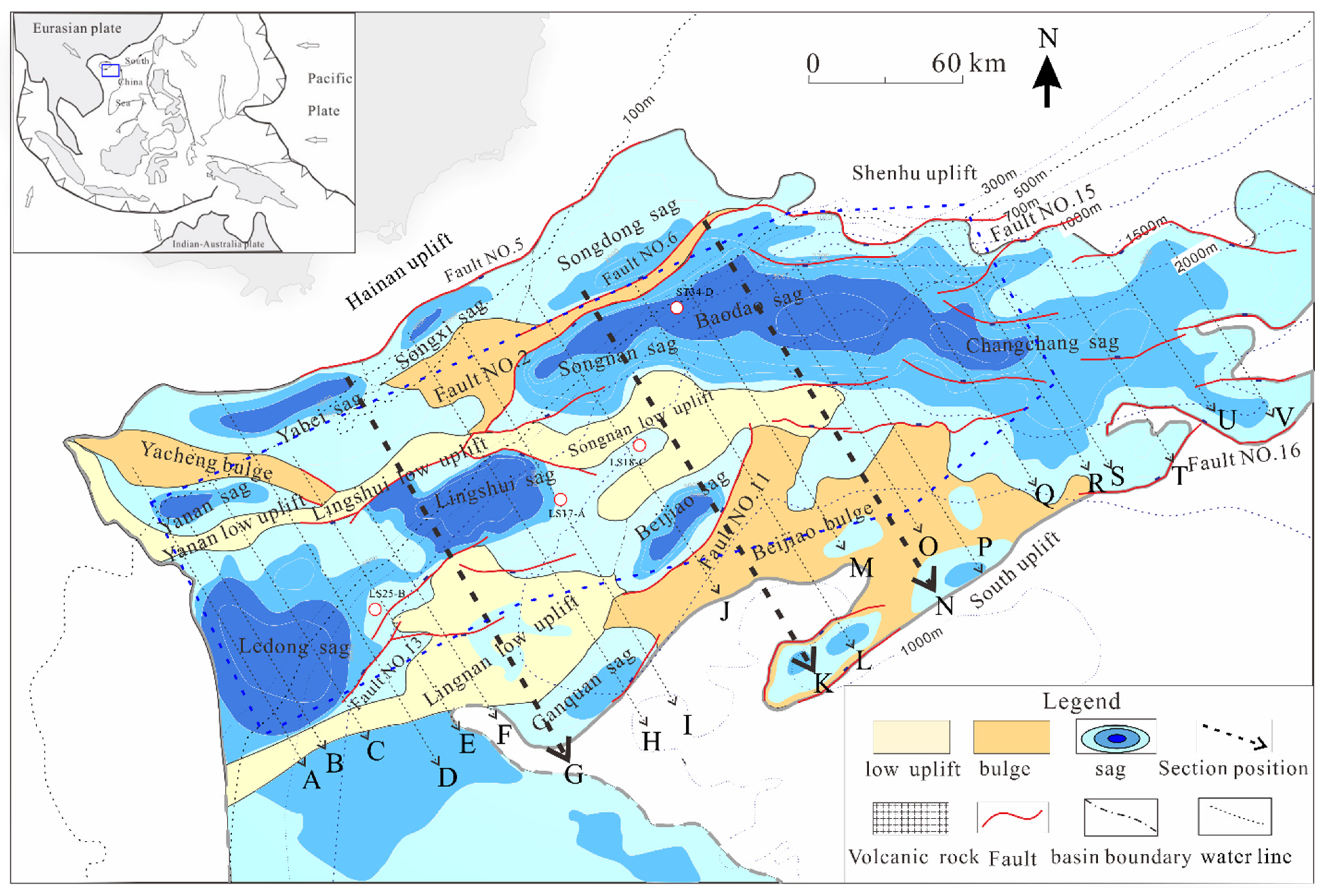
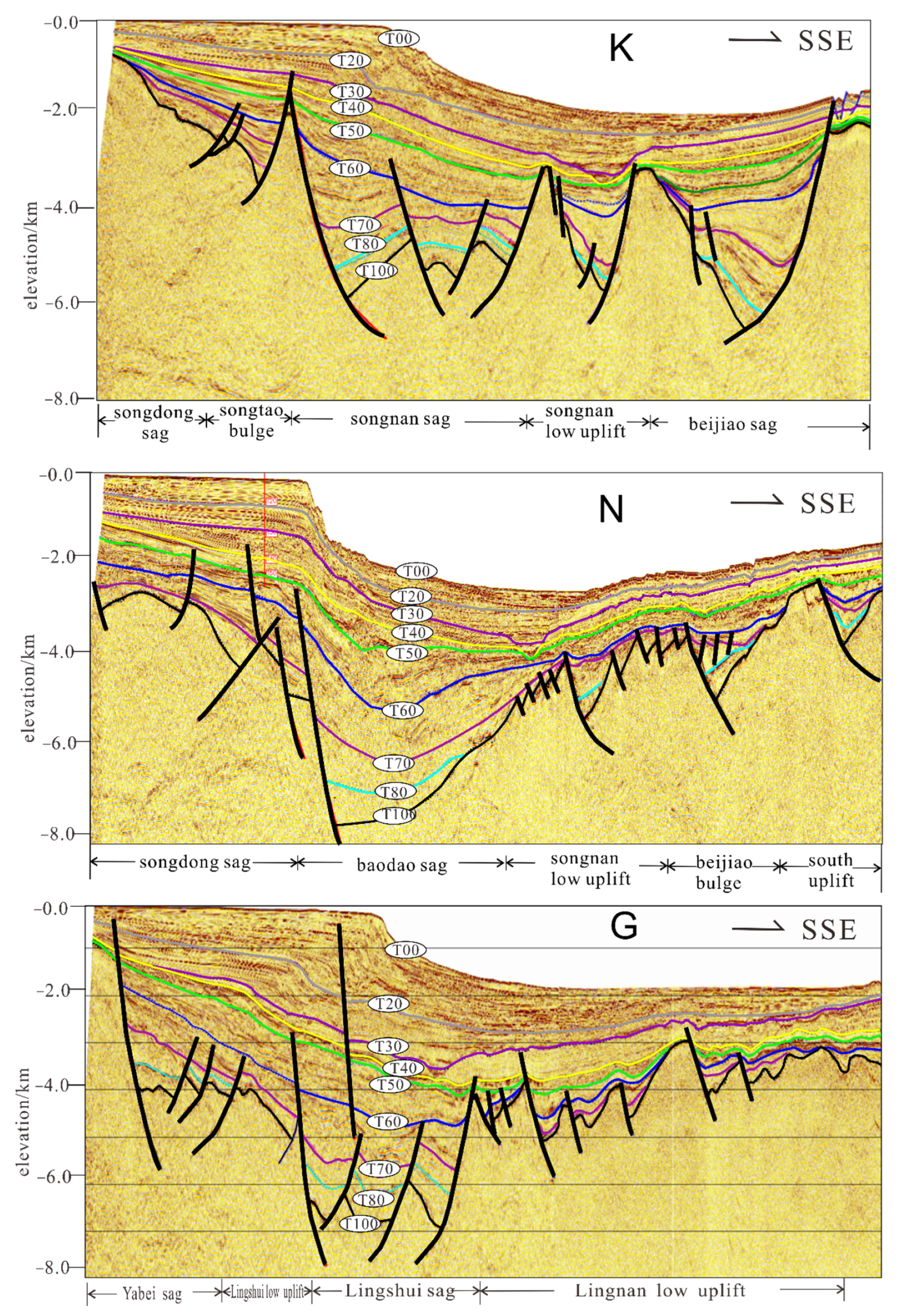
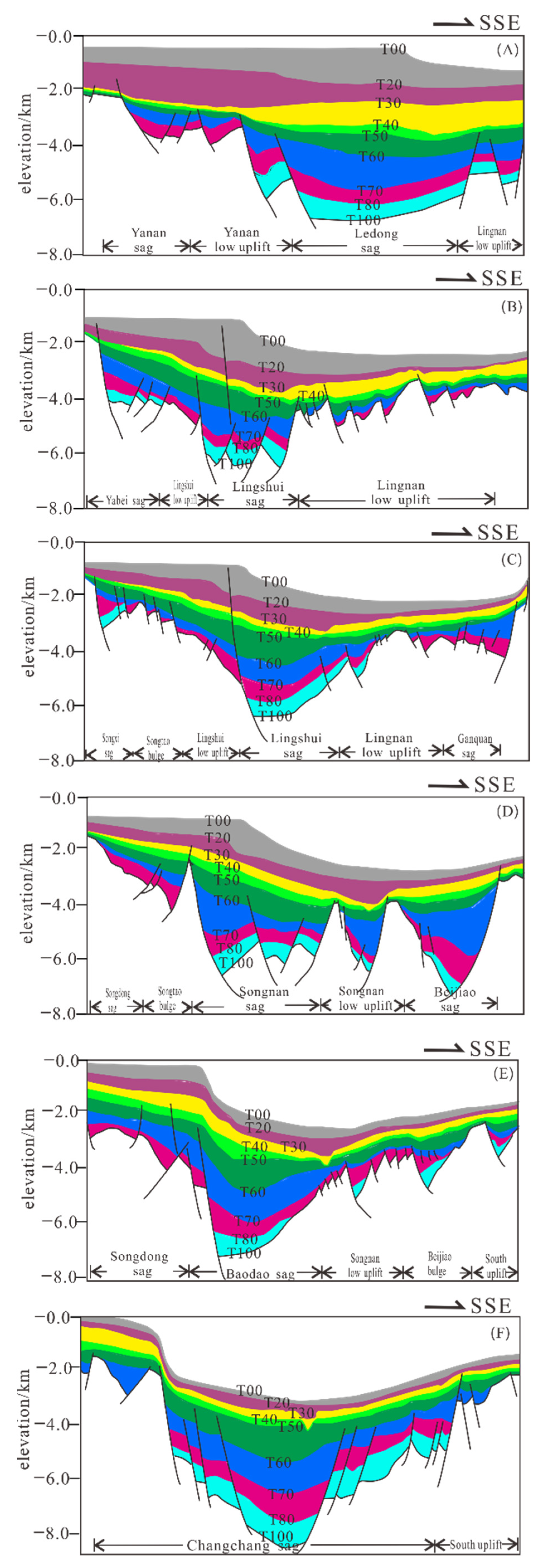
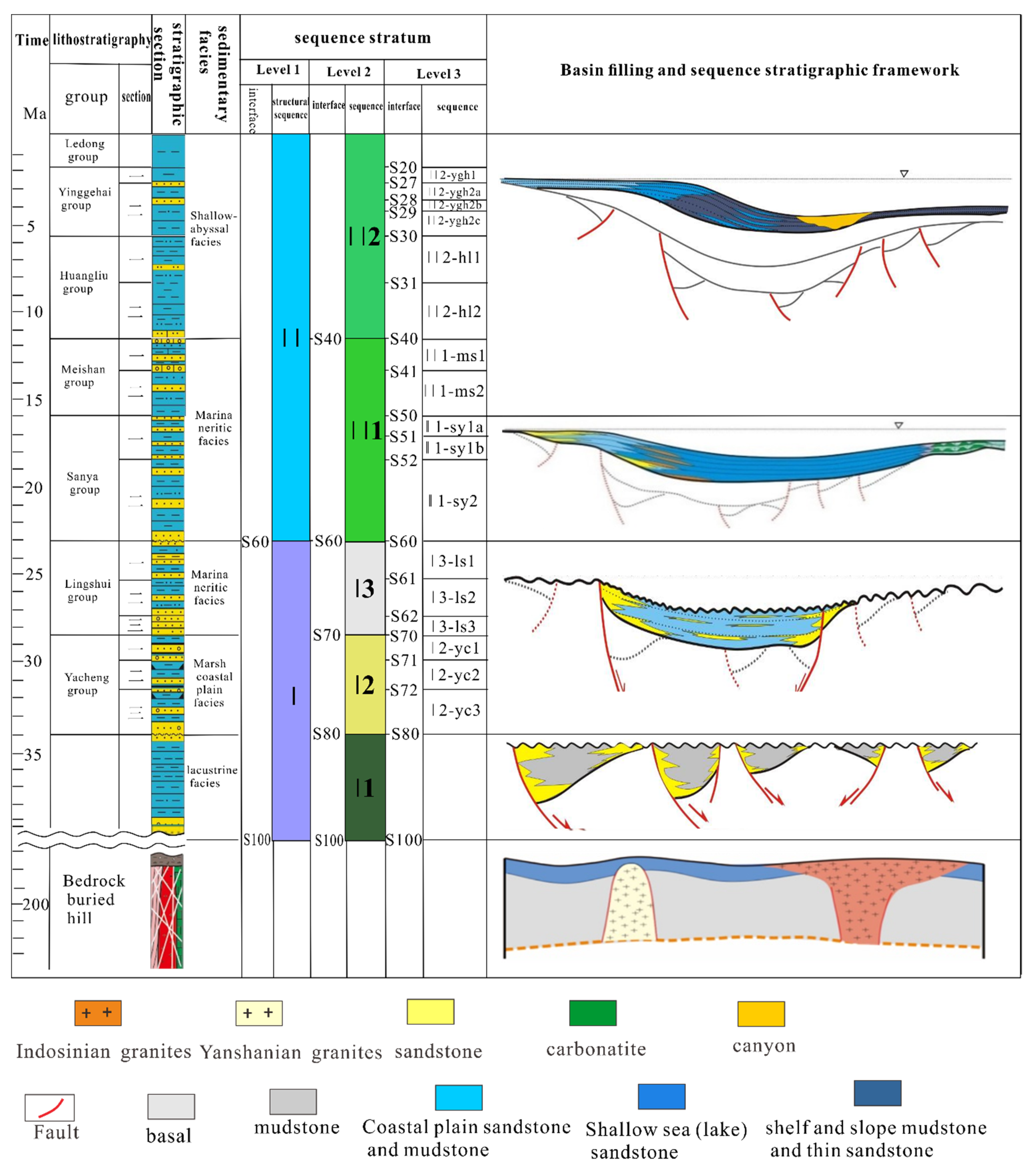
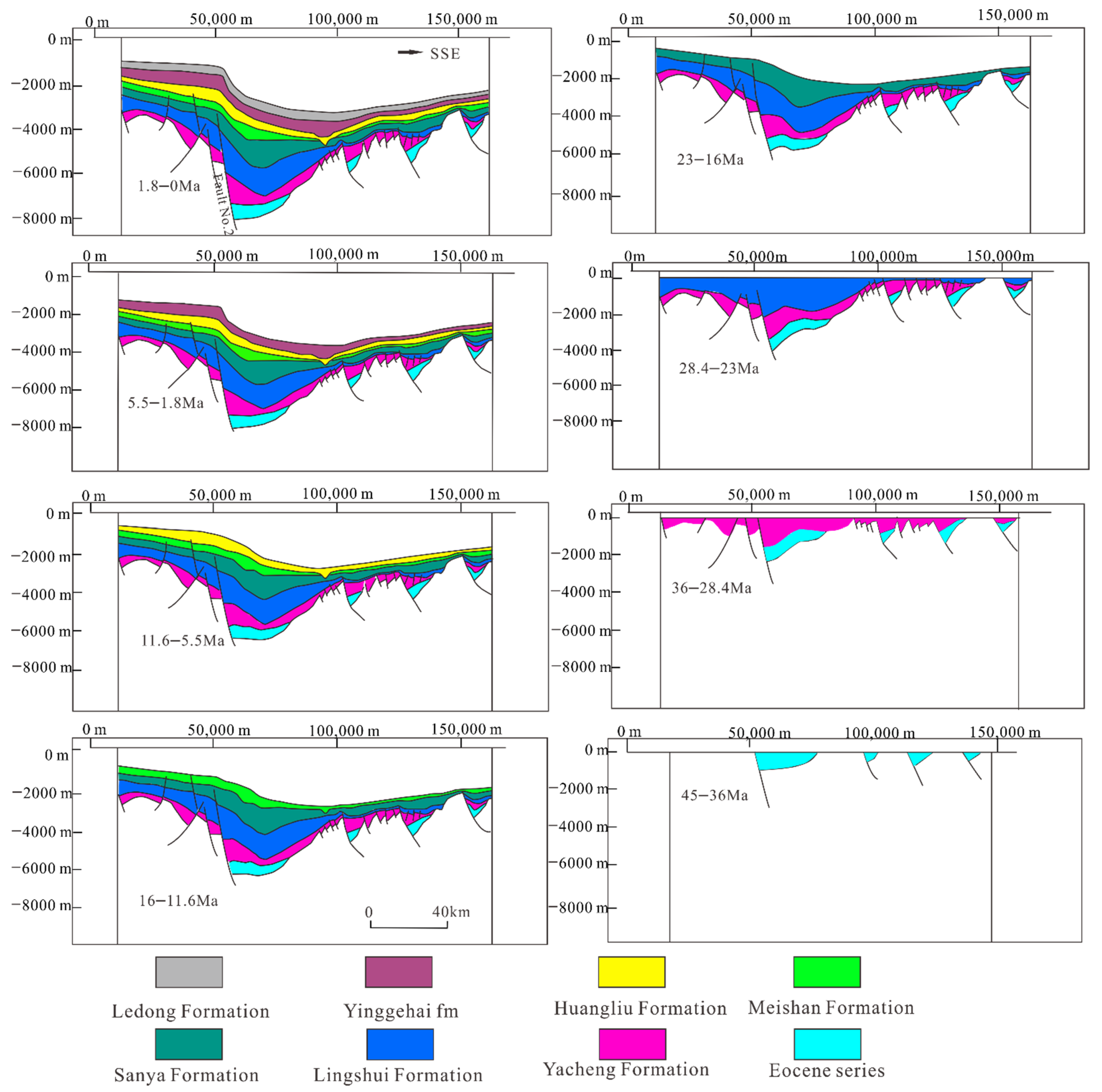
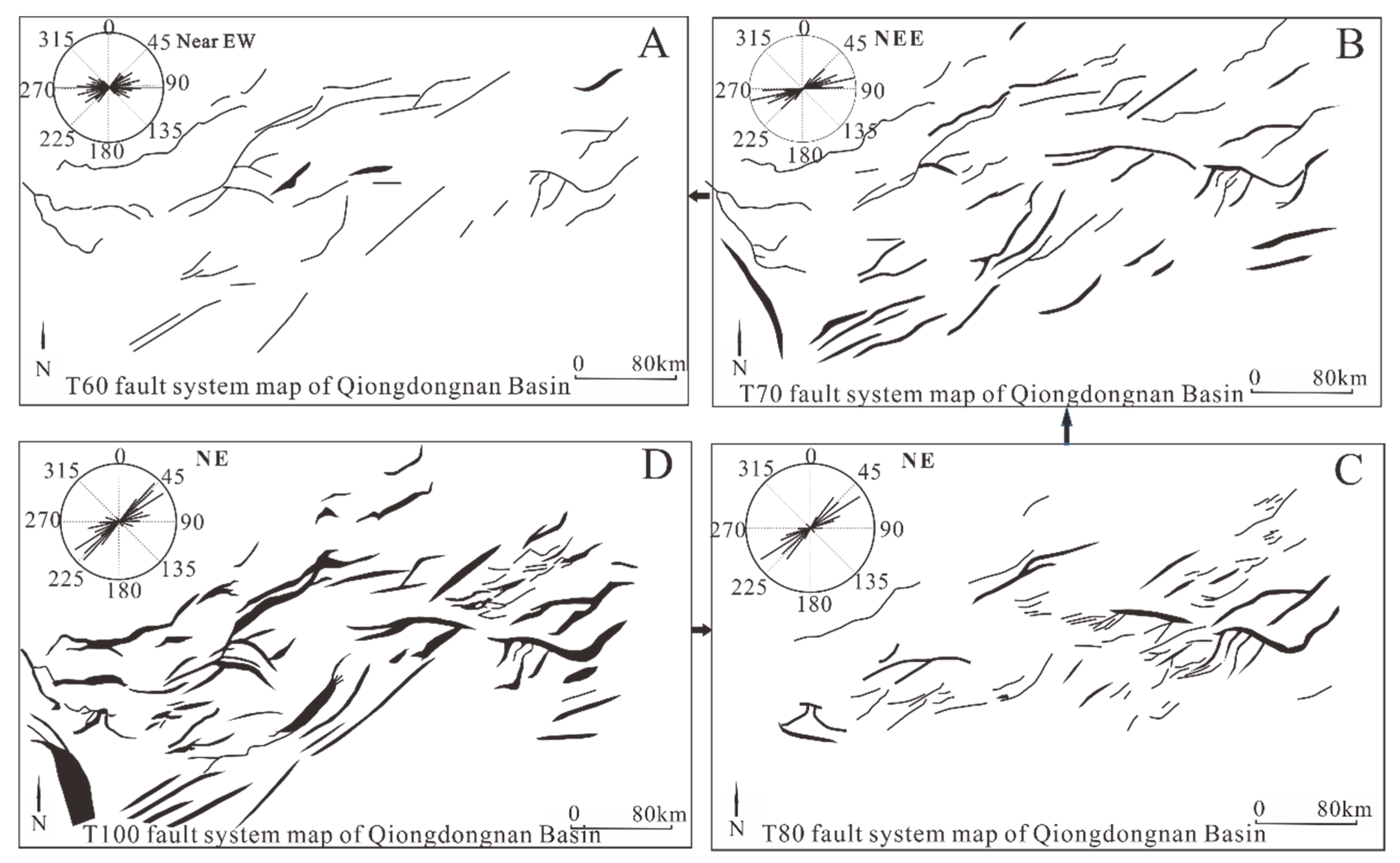
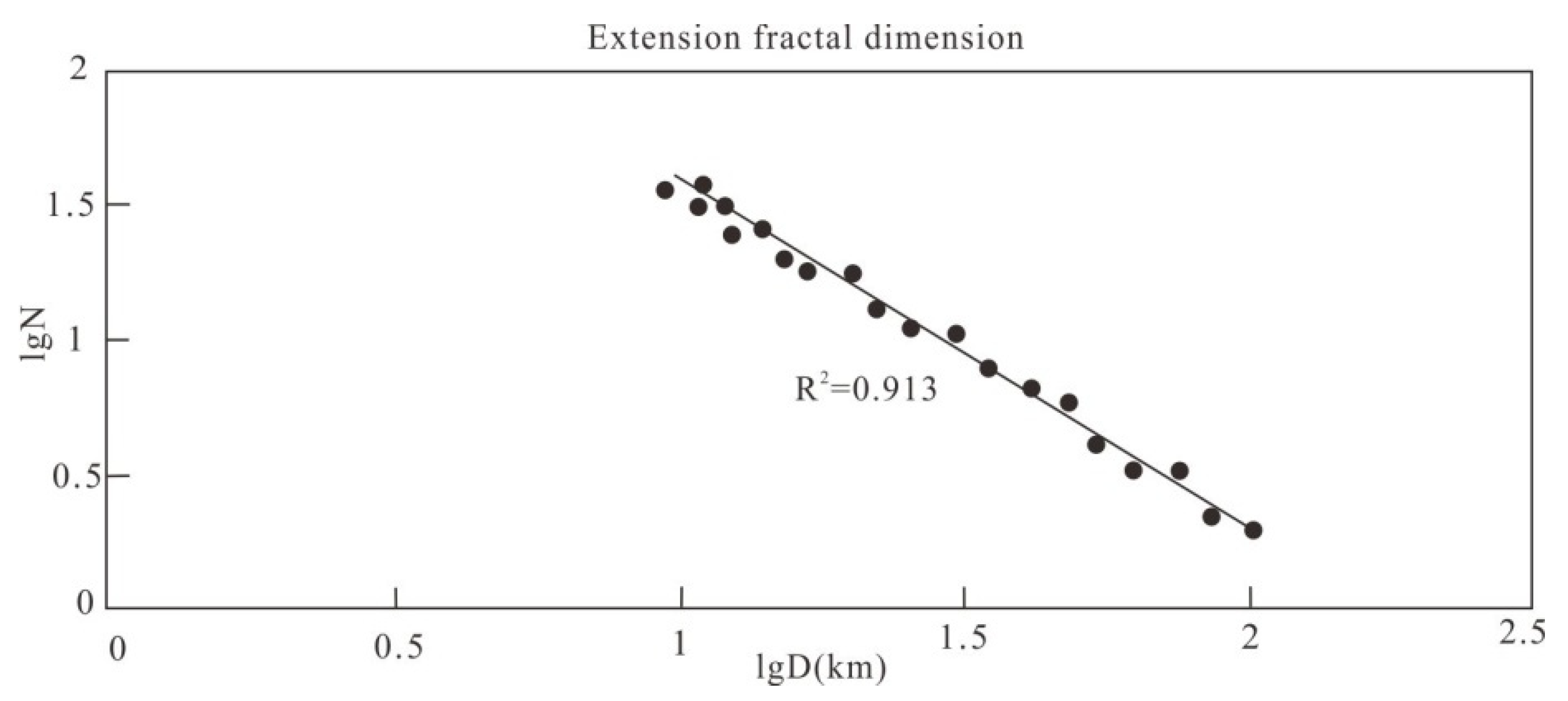

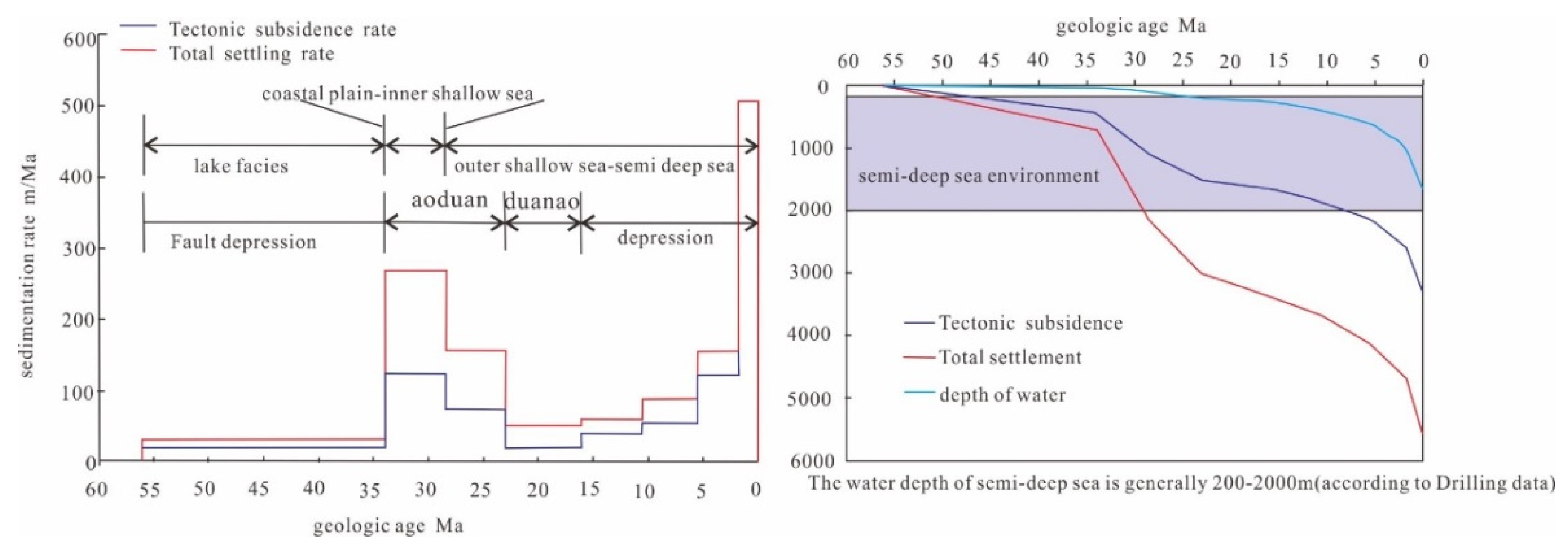
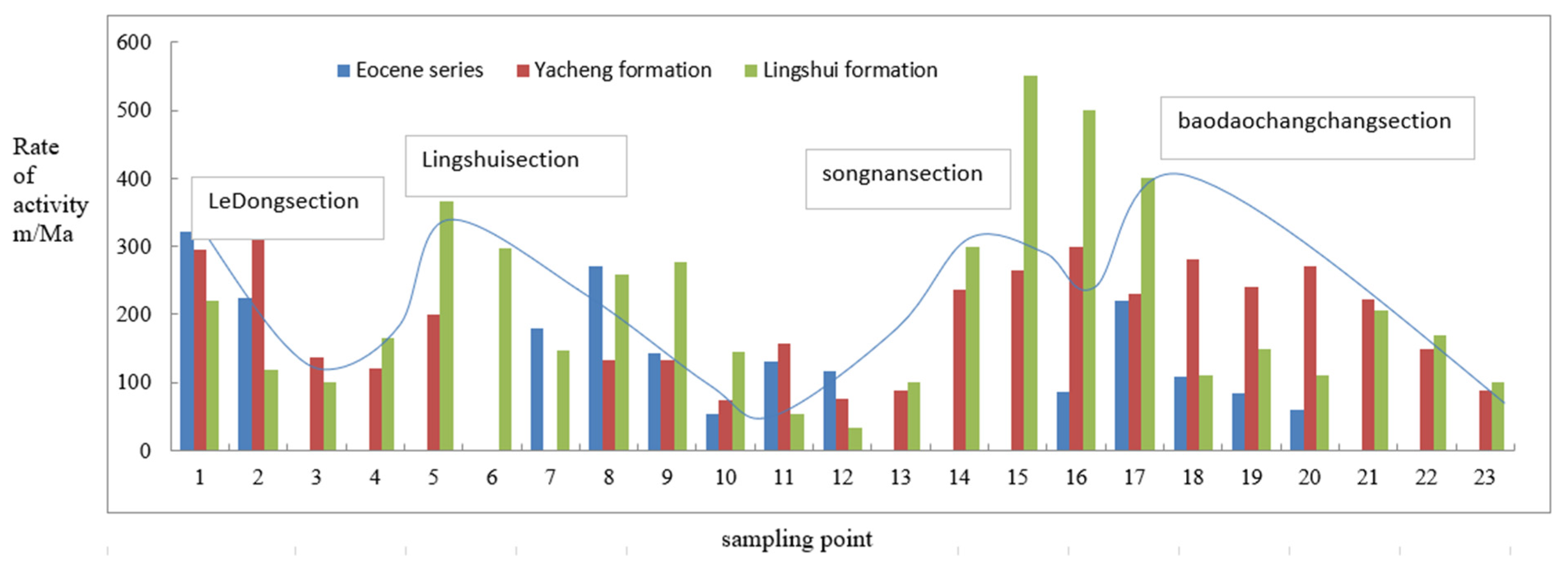
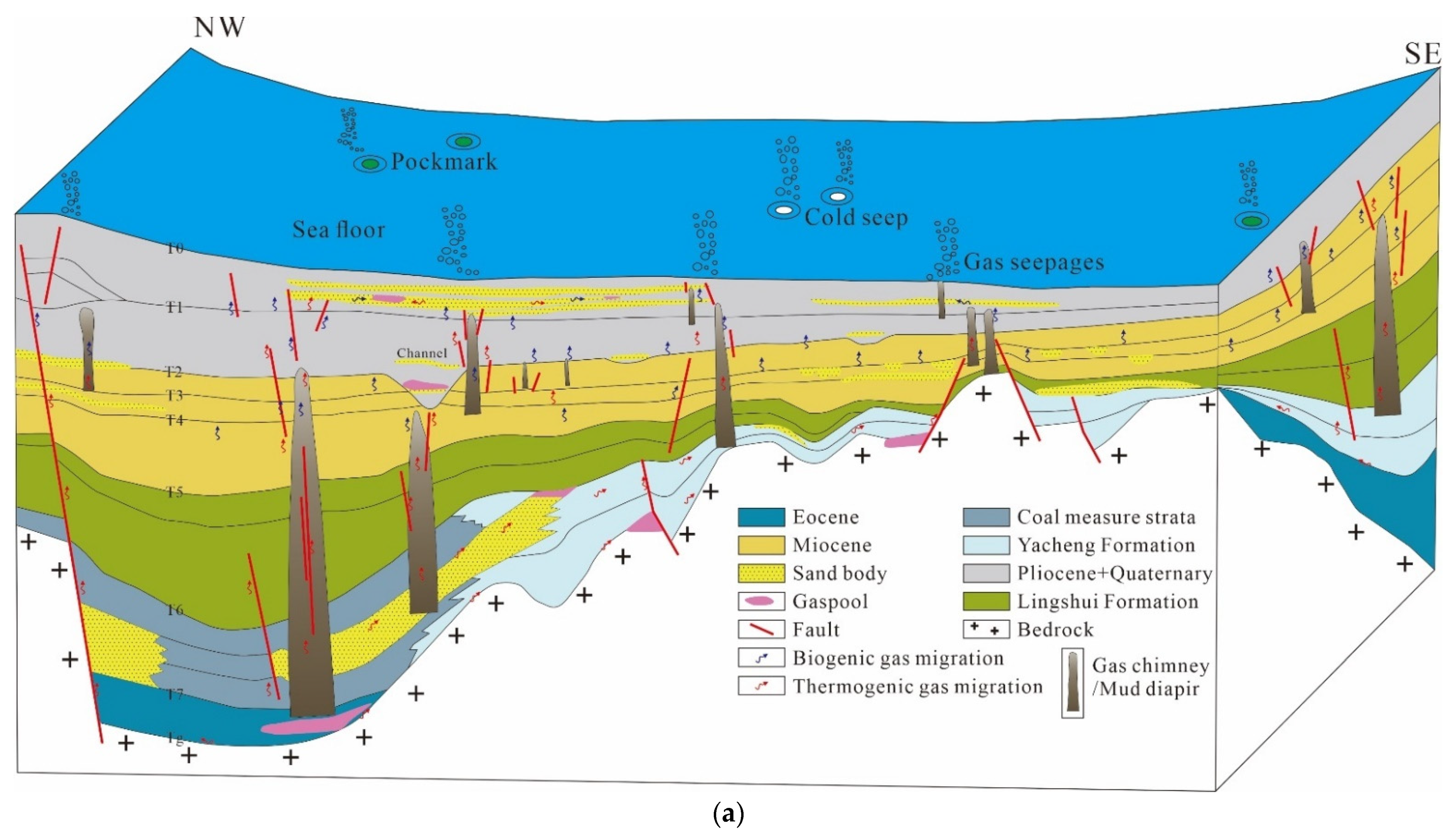
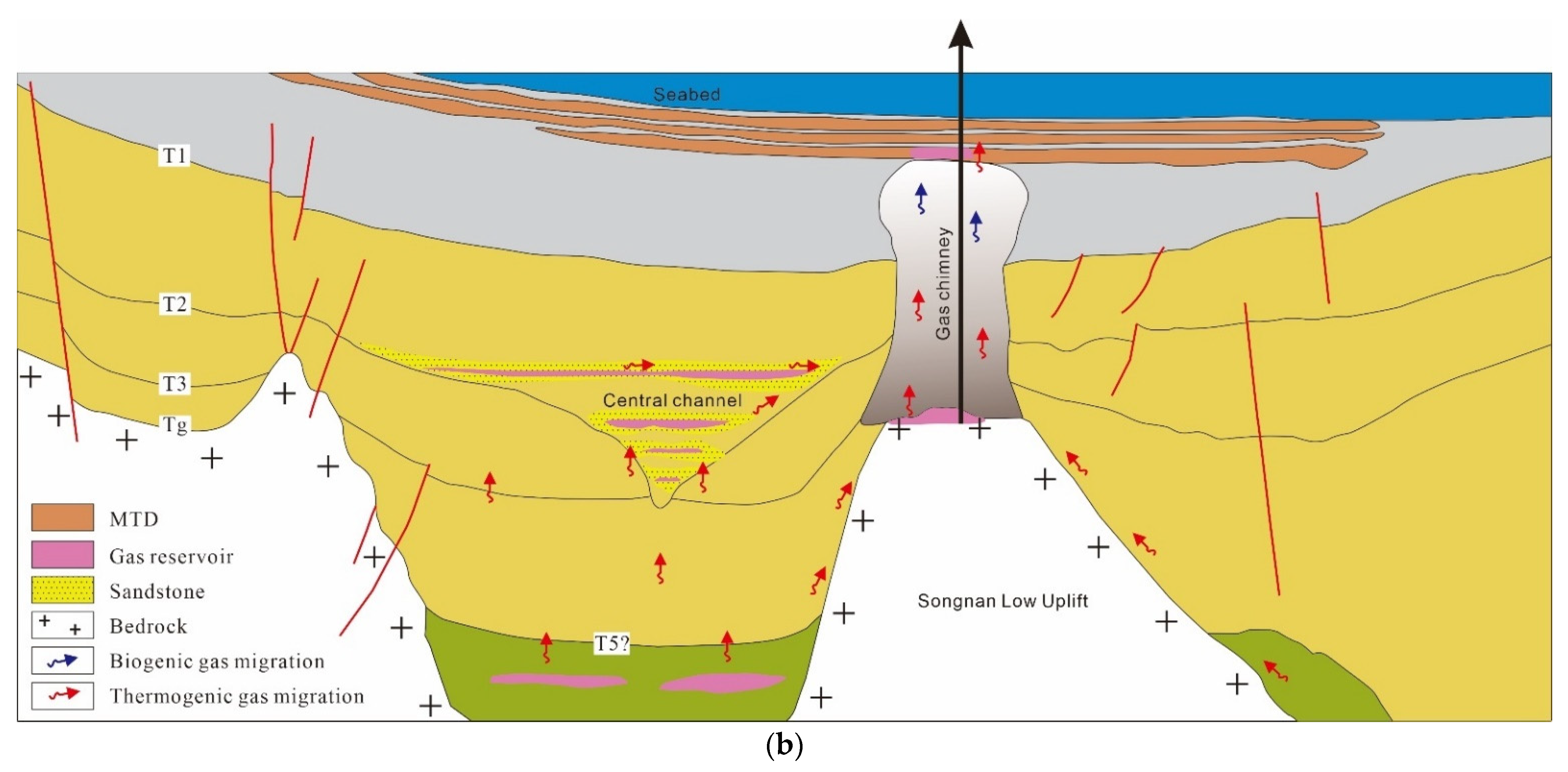
| Survey Line | Current Length of Line (km) | Horizontal GraphN (km) | Ԑhi (km) | he (km) | Calculation of Total Elongation by Fractal Method (km) | Calculation of Total Extension by Equilibrium Recovery Method (km) |
|---|---|---|---|---|---|---|
| 07e31033 | 198.53 | 1.7 | 47.28 | 3.91 | 51.19 | 46.58 |
Publisher’s Note: MDPI stays neutral with regard to jurisdictional claims in published maps and institutional affiliations. |
© 2022 by the authors. Licensee MDPI, Basel, Switzerland. This article is an open access article distributed under the terms and conditions of the Creative Commons Attribution (CC BY) license (https://creativecommons.org/licenses/by/4.0/).
Share and Cite
Zhang, Y.; Zhang, L.; Mi, L.; Lu, X.; Wu, S.; Tang, L.; Zhou, J.; Xiong, X.; Zhu, J. Quantitative Analysis of Cenozoic Extension in the Qiongdongnan Basin, South China Sea: Insight on Tectonic Control for Hydrocarbon Reservoir Accumulation and Formation. Energies 2022, 15, 4011. https://doi.org/10.3390/en15114011
Zhang Y, Zhang L, Mi L, Lu X, Wu S, Tang L, Zhou J, Xiong X, Zhu J. Quantitative Analysis of Cenozoic Extension in the Qiongdongnan Basin, South China Sea: Insight on Tectonic Control for Hydrocarbon Reservoir Accumulation and Formation. Energies. 2022; 15(11):4011. https://doi.org/10.3390/en15114011
Chicago/Turabian StyleZhang, Yan, Li Zhang, Lijun Mi, Xiangyang Lu, Shiguo Wu, Lishan Tang, Jie Zhou, Xiaofeng Xiong, and Jitian Zhu. 2022. "Quantitative Analysis of Cenozoic Extension in the Qiongdongnan Basin, South China Sea: Insight on Tectonic Control for Hydrocarbon Reservoir Accumulation and Formation" Energies 15, no. 11: 4011. https://doi.org/10.3390/en15114011
APA StyleZhang, Y., Zhang, L., Mi, L., Lu, X., Wu, S., Tang, L., Zhou, J., Xiong, X., & Zhu, J. (2022). Quantitative Analysis of Cenozoic Extension in the Qiongdongnan Basin, South China Sea: Insight on Tectonic Control for Hydrocarbon Reservoir Accumulation and Formation. Energies, 15(11), 4011. https://doi.org/10.3390/en15114011





